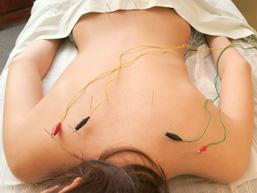PENS/PNT
Percutaneous Electrical Nerve Stimulation (PENS) or
Percutaneous Neuromodulation Therapy (PNT)
PENS is a minimally invasive electrical stimulation treatment for chronic pain. This works by helping to change the way pain nerves relay their pain message. No medication is injected. The needles used are extremely thin, like acupuncture needles. Up to 10 needles (5 electrical channels) are used. Small wires from a battery-powered electrical stimulator are used to deliver non-painful electrical stimulation near the nerves and in the tissues under the skin, such as the muscles.
Most patients feel a tolerable tapping or tingling sensation and do not find the treatment uncomfortable. A 20-30 minute treatment is given during the first session, and then further treatments are provided up to 10 times over several weeks. Many patients feel immediate improvement after the first or second treatment due to relaxation of muscle spasm, but it can take 4-5 treatments for the early benefit to be felt.
PNT/PENS is a type of neuromodulation. Neuromodulation is a category of treatment that is designed to alter the way the nervous system (nerves, spinal cord, and/or brain) transmits messages, such as the pain messages that occur when pain nerve cells are stimulated or damaged. Other types of neuromodulation include spinal cord stimulation for refractory pain, and transcranial magnetic stimulation, that is being tested for both depression and for chronic pain.
There are a few potential side effects to be considered with PENS, as with any medical treatment. There could be increased pain at the treatment locations. A bruise or bleeding could occur. Damage to a nerve or infection are possible but very unlikely. A collapsed lung could very rarely occur with treatment in the lower neck or in the chest area. You should not receive this treatment if you have a pacemaker or defibrillator.
PENS/PNT is different from TENS (transcutaneous electrical nerve stimulation) or electrical muscles stimulation on the skin that you may have experienced during physical therapy. There is a very high electrical impedance (resistance or blockage) of the skin which is overcome by the medical procedure of PENS/PNT.
Many patients are able to increase their activity and perform stretching exercises, which in turn reduces such secondary complications of chronic pain such as muscle spasm. In cases such as this, the benefits of PENS may prevent the recurrence of the pain-spasm-inactivity cycle which plagues so many patients.
The results of the treatments may last for a long time, but in some cases can be temporary. If needed, further treatments can be given on an as needed basis. As no medication is injected, there are no set limits as to the number of treatments that can be given. The pain relief provided by the treatment may allow you to reduce the amount of pain medication you are taking, but medication can still be used if necessary during the course of treatment.
PENS for Painful neuropathy:
An Evidence-Based Guideline on Treatment of Painful Diabetic Neuropathy from the American Association of Neuromuscular and Electrodiagnostic Medicine, the American Academy Of Neurology, and the American Academy of Physical Medicine & Rehabilitation concluded:
“Recommendations:
P.E.N.S.
Are you tired of suffering from chronic pain? Does it seem like nothing you try provides lasting relief? At Now Care Pain Relief, we understand how frustrating and debilitating persistent pain can be, and that’s why we offer the latest and most effective treatments, including P.E.N.S. This innovative therapy combines the ancient practice of acupuncture with modern technology to provide a safe, non-invasive, and drug-free solution to pain relief. In this article, we’ll explore how P.E.N.S. works, how it can help you, and what to expect during your treatment.
Patient Assessment
At Now Care Pain Relief, we believe that every patient is unique and requires an individualized treatment plan. Before starting P.E.N.S. therapy, we will perform a thorough patient assessment to determine your specific needs and develop a personalized treatment plan. This will include a detailed medical history and physical examination, as well as a discussion of your symptoms, lifestyle, and overall health goals.
During the assessment, our chiropractors will also explain how P.E.N.S. works and what you can expect during the treatment. We’ll answer any questions you may have and ensure that you feel comfortable and confident in your decision to try P.E.N.S. therapy.
Electrode Placement
Once we have completed your patient assessment, we will begin the P.E.N.S. treatment. This involves placing small electrodes on specific points on your body, which are determined based on your individual needs and symptoms. The electrodes are connected to a device that delivers a low-frequency electrical current, which stimulates the nerves and muscles in the targeted areas.
The electrode placement is a crucial part of P.E.N.S. therapy, as it allows for precise targeting of the affected areas and ensures the most effective results. Our chiropractors are highly trained in electrode placement and will take great care to ensure your comfort and safety throughout the treatment.
During the treatment, you may experience a slight tingling sensation or mild discomfort at the electrode sites, but this is temporary and should subside quickly. Most patients find P.E.N.S. therapy to be relaxing and even enjoyable, as it can help release tension and promote a sense of well-being.
Electrical Stimulation
P.E.N.S. therapy involves the use of a small, battery-operated device that delivers electrical stimulation through small electrodes placed on the skin. The electrical current stimulates the nerves and muscles in the targeted areas, promoting healing and reducing pain and inflammation. The electrical stimulation also triggers the release of endorphins, which are natural painkillers produced by the body.
Electrical stimulation has been used for decades as a safe and effective treatment for a wide range of conditions, including chronic pain, muscle spasms, and nerve damage. P.E.N.S. therapy takes this approach to the next level by combining electrical stimulation with the precise targeting of acupuncture points, allowing for a more targeted and effective treatment.
During P.E.N.S. therapy, our chiropractors will adjust the intensity of the electrical current to ensure that you are comfortable throughout the treatment. Many patients find the sensation of electrical stimulation to be pleasant and relaxing, with some even falling asleep during the treatment.
Needle Insertion
One of the key components of P.E.N.S. therapy is the use of acupuncture needles. These needles are much smaller than the needles used for injections and are designed to be virtually painless. The needles are inserted into specific acupuncture points on the skin, which are determined based on your individual needs and symptoms.
The needles are left in place for several minutes, during which time you may feel a slight tingling or warmth at the insertion site. This is normal and indicates that the acupuncture point is being stimulated, promoting healing and reducing pain and inflammation.
Our chiropractors are highly trained in the insertion of acupuncture needles and take great care to ensure your safety and comfort throughout the treatment. We use sterile needles and follow strict protocols to prevent infection and ensure optimal results.
Stimulation
P.E.N.S. Therapy uses a small, battery-operated device that delivers electrical stimulation to specific acupuncture points on the skin. The electrical current stimulates the nerves and muscles in the targeted areas, promoting healing and reducing pain and inflammation. This stimulation also triggers the release of endorphins, which are natural painkillers produced by the body.
Electrical stimulation has been shown to be a safe and effective treatment for a wide range of conditions, including chronic pain, muscle spasms, and nerve damage. With P.E.N.S. therapy, the stimulation is delivered precisely to the targeted acupuncture points, making it a more effective treatment for pain relief.
Our chiropractors will adjust the intensity of the electrical current to ensure that you are comfortable throughout the treatment. Many patients find the sensation of electrical stimulation to be pleasant and relaxing, with some even falling asleep during the treatment.
Treatment Duration
P.E.N.S. Therapy is a fast and effective treatment option for chronic pain. The treatment duration varies depending on the severity of your condition and your individual needs. In most cases, a typical treatment session lasts between 20 and 30 minutes.
The number of treatment sessions needed will also vary depending on your individual needs and goals. Our chiropractors will work with you to develop a personalized treatment plan that is tailored to your unique needs and will help you achieve the best possible results.
Most patients experience significant pain relief after just a few P.E.N.S. therapy sessions, with some experiencing immediate relief. However, it is important to note that individual results may vary, and it may take several sessions before you see significant improvement.
Post-Treatment Care
After a P.E.N.S. therapy session, it is important to take care of yourself to support the healing process. Here are some post-treatment care tips to keep in mind:
- Stay Hydrated: Drinking plenty of water after your treatment can help flush out toxins from your body and promote healing.
- Avoid Strenuous Activity: While P.E.N.S. therapy is a non-invasive treatment, it is important to give your body time to heal. Avoid strenuous activity or exercise for at least 24 hours after your treatment.
- Apply Heat or Ice: Depending on your individual needs and the location of the treatment, you may benefit from applying heat or ice to the affected area. Consult with your chiropractor to determine the best approach for you.
- Get Plenty of Rest: Rest is an important part of the healing process. Make sure you get plenty of rest and allow your body time to recover.
- Follow Your Chiropractor’s Instructions: Your chiropractor will provide you with specific post-treatment care instructions based on your individual needs and goals. Be sure to follow their instructions carefully to ensure the best possible outcomes.
Benefits of Proper Post-Treatment Care
By following these post-treatment care tips, you can help maximize the benefits of P.E.N.S. therapy and promote a successful recovery. Some of the benefits of proper post-treatment care include:
- Reduced Pain and Inflammation: Proper post-treatment care can help reduce pain and inflammation, allowing you to recover more quickly and comfortably.
- Improved Range of Motion and Flexibility: By supporting the healing process, you can improve your range of motion and flexibility, making it easier to perform daily activities and enjoy your favorite hobbies.
- Faster Recovery Time: By taking care of yourself after a P.E.N.S. therapy session, you can speed up the recovery process and get back to your normal routine more quickly.
- Better Overall Health and Wellness: Proper post-treatment care can help improve your overall health and wellness, allowing you to enjoy a better quality of life.
At Now Care Pain Relief, we are committed to providing our patients with the best possible care and support for their pain management needs. By following these post-treatment care tips and working closely with our chiropractors, you can achieve the best possible outcomes with P.E.N.S. therapy.
P.E.N.S. therapy is an innovative and effective treatment option for chronic pain, but it is important to follow the proper post-treatment care instructions to maximize its benefits. By staying hydrated, avoiding strenuous activity, applying heat or ice, getting plenty of rest, and following your chiropractor’s instructions, you can support the healing process and achieve the best possible outcomes. At Now Care Pain Relief, we are here to support you every step of the way on your journey to pain relief and improved wellness. Contact us today to schedule a consultation and learn more about the benefits of P.E.N.S. therapy.


